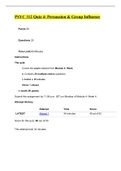Samenvatting
Summary exam Strategic Analytics - Master strategic management
- Instelling
- Tilburg University (UVT)
summary of the web clips for exam strategic analytics for master strategic management @UVT, which is a summary of the book for the exam
[Meer zien]













